Auckland Airport Authority: Economic Analysis and Performance Review
VerifiedAdded on 2022/08/26
|22
|5191
|15
Report
AI Summary
This report provides an in-depth economic analysis of the Auckland International Airport Authority, examining its role in New Zealand's economy. It begins with an introduction to the airport's location, business operations, and customer base, including details on its main customers and competitors. The report then delves into the airport's production costs, including fixed and variable costs, and analyzes the macroeconomic environment, such as inflation, unemployment, and exchange rates, influencing its business. Furthermore, it explores the airport's sustainability practices, including positive and negative externalities. The analysis also includes the company's market share and financial performance, based on its annual financial report, including profit, dividend, and capital expenditure. The report aims to provide a comprehensive overview of the airport's economic significance and its approach to sustainable development.

Running head: ECONOMICS FOR SUSTAINABLE DEVELOPMENT
Economics for Sustainable Development
Name of the Student
Name of the University
Author Note
Economics for Sustainable Development
Name of the Student
Name of the University
Author Note
Paraphrase This Document
Need a fresh take? Get an instant paraphrase of this document with our AI Paraphraser
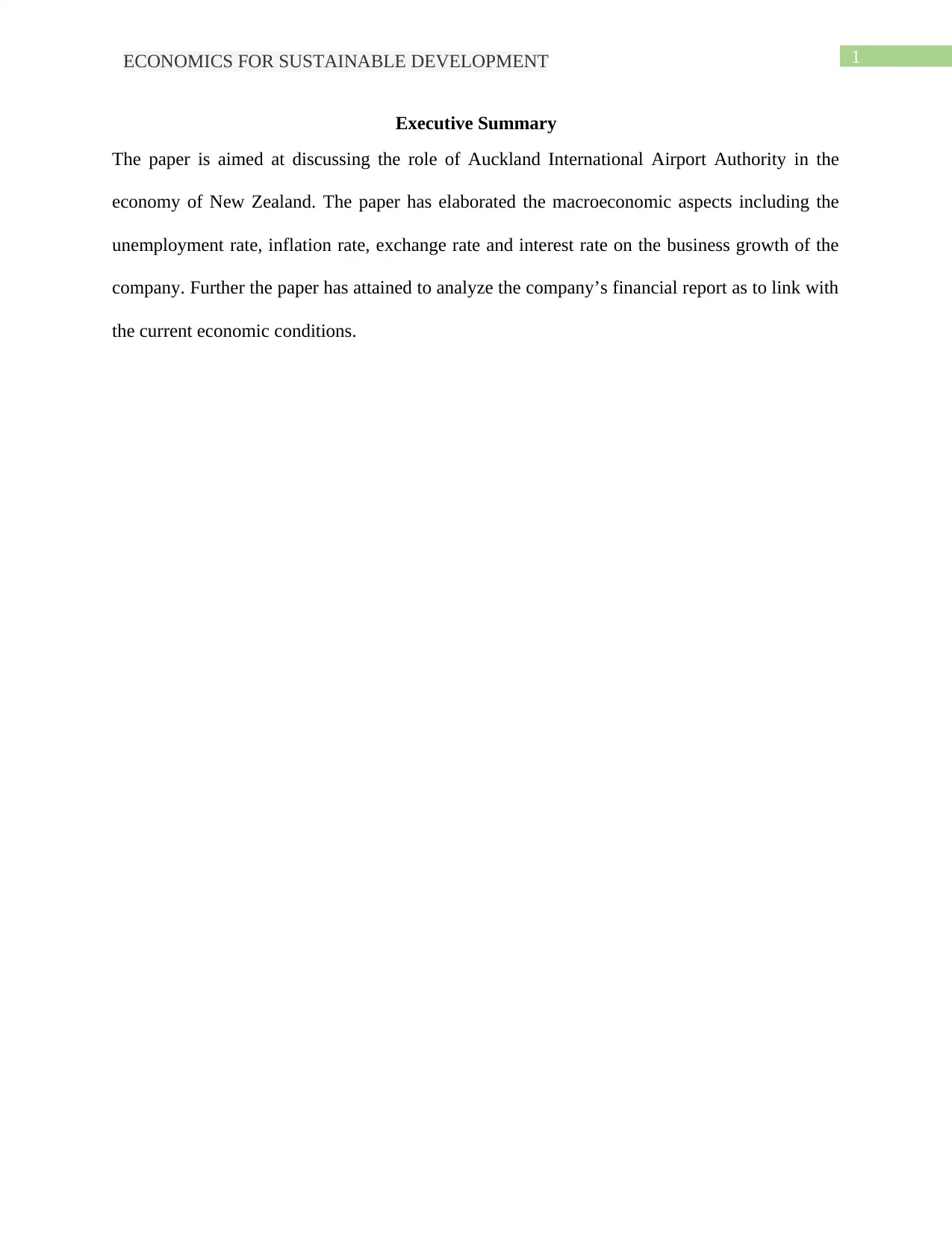
1ECONOMICS FOR SUSTAINABLE DEVELOPMENT
Executive Summary
The paper is aimed at discussing the role of Auckland International Airport Authority in the
economy of New Zealand. The paper has elaborated the macroeconomic aspects including the
unemployment rate, inflation rate, exchange rate and interest rate on the business growth of the
company. Further the paper has attained to analyze the company’s financial report as to link with
the current economic conditions.
Executive Summary
The paper is aimed at discussing the role of Auckland International Airport Authority in the
economy of New Zealand. The paper has elaborated the macroeconomic aspects including the
unemployment rate, inflation rate, exchange rate and interest rate on the business growth of the
company. Further the paper has attained to analyze the company’s financial report as to link with
the current economic conditions.
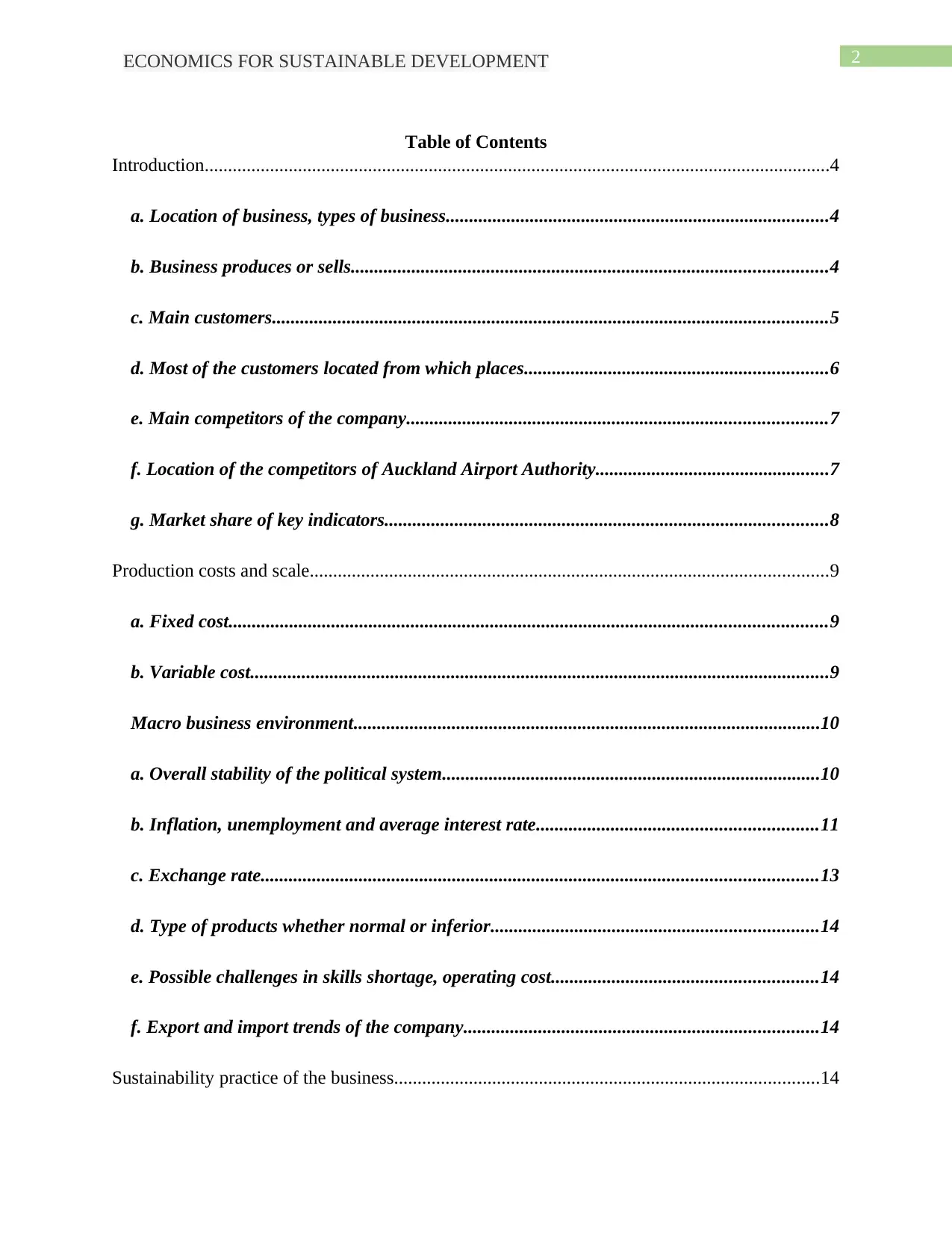
2ECONOMICS FOR SUSTAINABLE DEVELOPMENT
Table of Contents
Introduction......................................................................................................................................4
a. Location of business, types of business..................................................................................4
b. Business produces or sells......................................................................................................4
c. Main customers.......................................................................................................................5
d. Most of the customers located from which places.................................................................6
e. Main competitors of the company..........................................................................................7
f. Location of the competitors of Auckland Airport Authority..................................................7
g. Market share of key indicators...............................................................................................8
Production costs and scale...............................................................................................................9
a. Fixed cost................................................................................................................................9
b. Variable cost............................................................................................................................9
Macro business environment....................................................................................................10
a. Overall stability of the political system.................................................................................10
b. Inflation, unemployment and average interest rate............................................................11
c. Exchange rate.......................................................................................................................13
d. Type of products whether normal or inferior......................................................................14
e. Possible challenges in skills shortage, operating cost.........................................................14
f. Export and import trends of the company............................................................................14
Sustainability practice of the business...........................................................................................14
Table of Contents
Introduction......................................................................................................................................4
a. Location of business, types of business..................................................................................4
b. Business produces or sells......................................................................................................4
c. Main customers.......................................................................................................................5
d. Most of the customers located from which places.................................................................6
e. Main competitors of the company..........................................................................................7
f. Location of the competitors of Auckland Airport Authority..................................................7
g. Market share of key indicators...............................................................................................8
Production costs and scale...............................................................................................................9
a. Fixed cost................................................................................................................................9
b. Variable cost............................................................................................................................9
Macro business environment....................................................................................................10
a. Overall stability of the political system.................................................................................10
b. Inflation, unemployment and average interest rate............................................................11
c. Exchange rate.......................................................................................................................13
d. Type of products whether normal or inferior......................................................................14
e. Possible challenges in skills shortage, operating cost.........................................................14
f. Export and import trends of the company............................................................................14
Sustainability practice of the business...........................................................................................14
⊘ This is a preview!⊘
Do you want full access?
Subscribe today to unlock all pages.

Trusted by 1+ million students worldwide
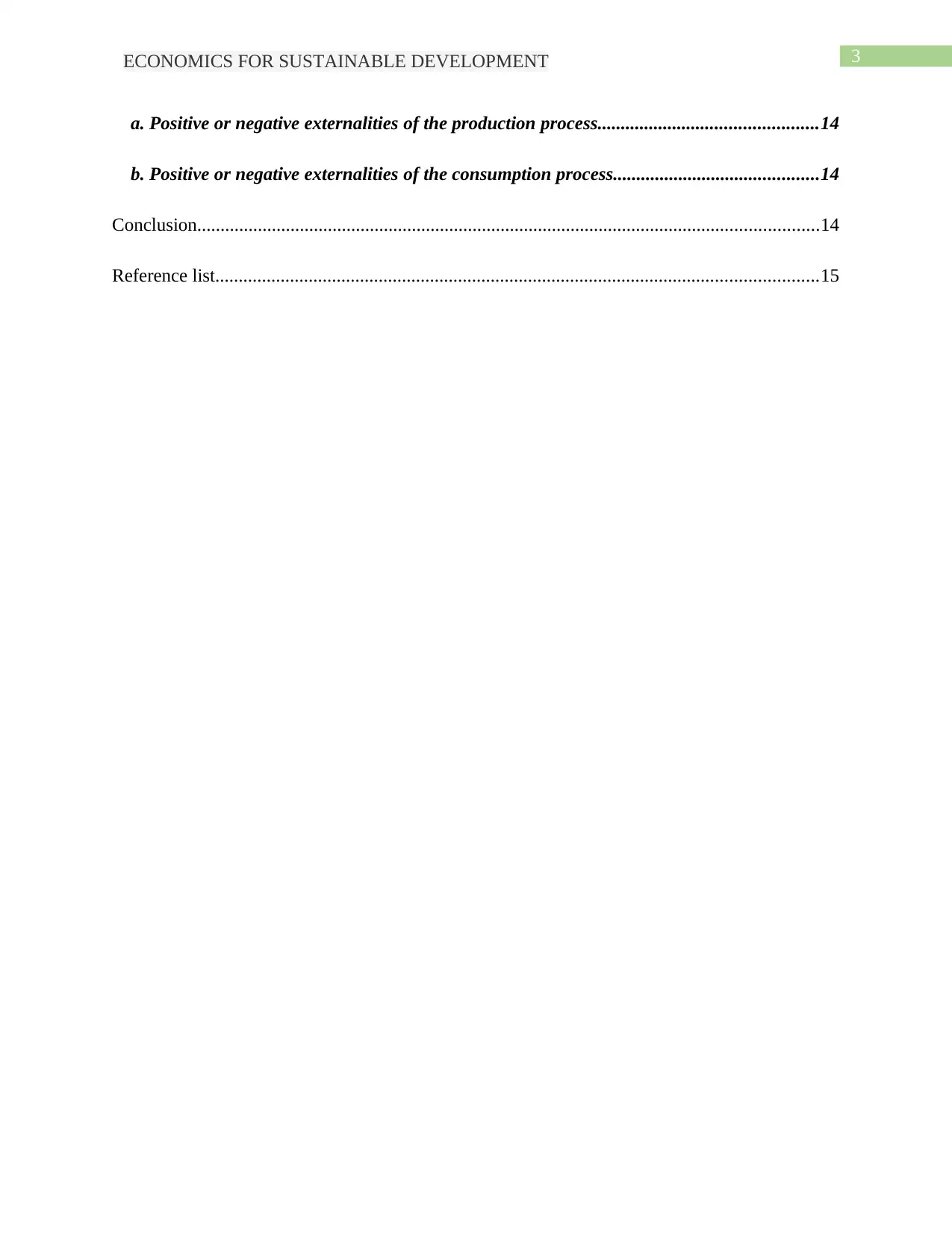
3ECONOMICS FOR SUSTAINABLE DEVELOPMENT
a. Positive or negative externalities of the production process...............................................14
b. Positive or negative externalities of the consumption process............................................14
Conclusion.....................................................................................................................................14
Reference list.................................................................................................................................15
a. Positive or negative externalities of the production process...............................................14
b. Positive or negative externalities of the consumption process............................................14
Conclusion.....................................................................................................................................14
Reference list.................................................................................................................................15
Paraphrase This Document
Need a fresh take? Get an instant paraphrase of this document with our AI Paraphraser
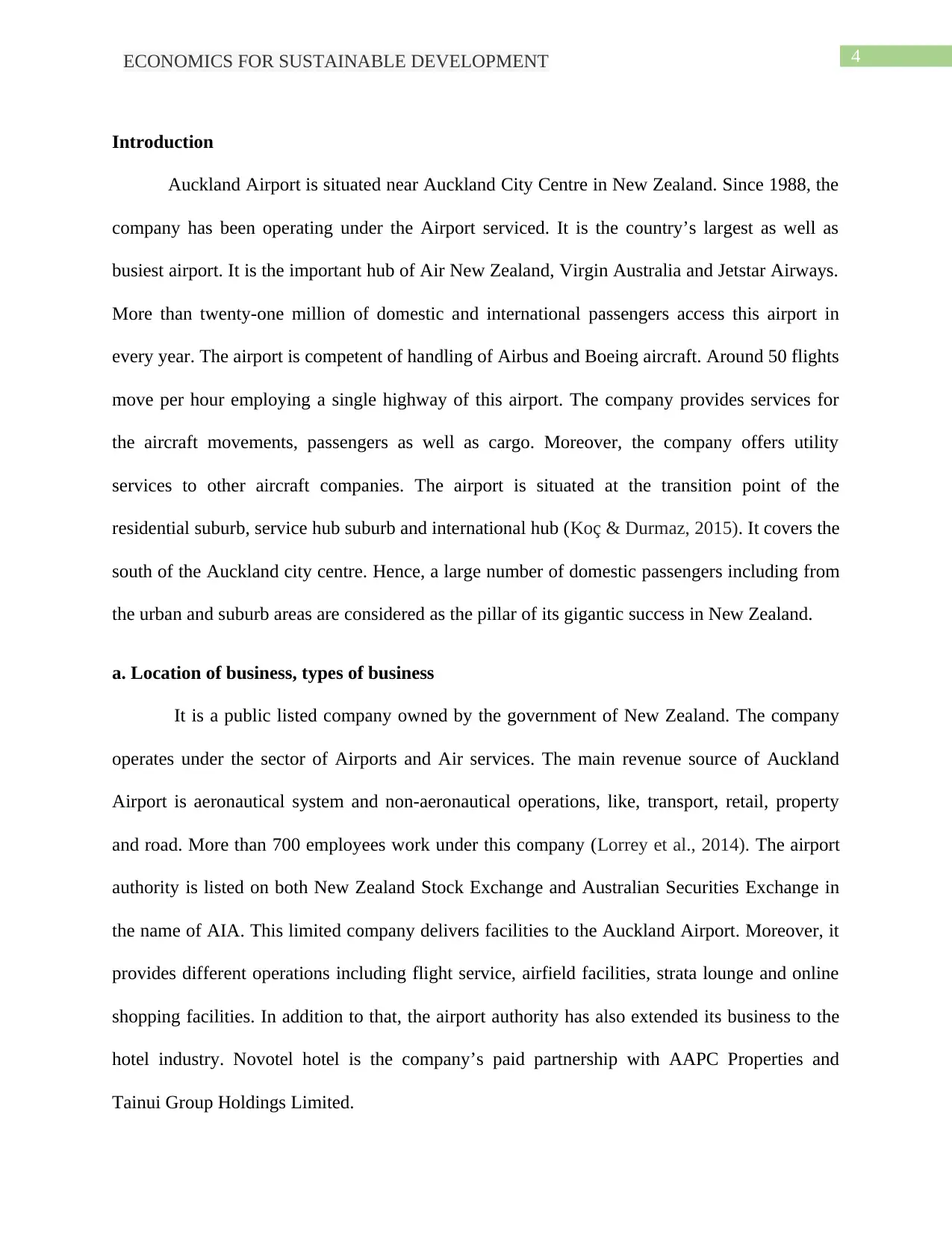
4ECONOMICS FOR SUSTAINABLE DEVELOPMENT
Introduction
Auckland Airport is situated near Auckland City Centre in New Zealand. Since 1988, the
company has been operating under the Airport serviced. It is the country’s largest as well as
busiest airport. It is the important hub of Air New Zealand, Virgin Australia and Jetstar Airways.
More than twenty-one million of domestic and international passengers access this airport in
every year. The airport is competent of handling of Airbus and Boeing aircraft. Around 50 flights
move per hour employing a single highway of this airport. The company provides services for
the aircraft movements, passengers as well as cargo. Moreover, the company offers utility
services to other aircraft companies. The airport is situated at the transition point of the
residential suburb, service hub suburb and international hub (Koç & Durmaz, 2015). It covers the
south of the Auckland city centre. Hence, a large number of domestic passengers including from
the urban and suburb areas are considered as the pillar of its gigantic success in New Zealand.
a. Location of business, types of business
It is a public listed company owned by the government of New Zealand. The company
operates under the sector of Airports and Air services. The main revenue source of Auckland
Airport is aeronautical system and non-aeronautical operations, like, transport, retail, property
and road. More than 700 employees work under this company (Lorrey et al., 2014). The airport
authority is listed on both New Zealand Stock Exchange and Australian Securities Exchange in
the name of AIA. This limited company delivers facilities to the Auckland Airport. Moreover, it
provides different operations including flight service, airfield facilities, strata lounge and online
shopping facilities. In addition to that, the airport authority has also extended its business to the
hotel industry. Novotel hotel is the company’s paid partnership with AAPC Properties and
Tainui Group Holdings Limited.
Introduction
Auckland Airport is situated near Auckland City Centre in New Zealand. Since 1988, the
company has been operating under the Airport serviced. It is the country’s largest as well as
busiest airport. It is the important hub of Air New Zealand, Virgin Australia and Jetstar Airways.
More than twenty-one million of domestic and international passengers access this airport in
every year. The airport is competent of handling of Airbus and Boeing aircraft. Around 50 flights
move per hour employing a single highway of this airport. The company provides services for
the aircraft movements, passengers as well as cargo. Moreover, the company offers utility
services to other aircraft companies. The airport is situated at the transition point of the
residential suburb, service hub suburb and international hub (Koç & Durmaz, 2015). It covers the
south of the Auckland city centre. Hence, a large number of domestic passengers including from
the urban and suburb areas are considered as the pillar of its gigantic success in New Zealand.
a. Location of business, types of business
It is a public listed company owned by the government of New Zealand. The company
operates under the sector of Airports and Air services. The main revenue source of Auckland
Airport is aeronautical system and non-aeronautical operations, like, transport, retail, property
and road. More than 700 employees work under this company (Lorrey et al., 2014). The airport
authority is listed on both New Zealand Stock Exchange and Australian Securities Exchange in
the name of AIA. This limited company delivers facilities to the Auckland Airport. Moreover, it
provides different operations including flight service, airfield facilities, strata lounge and online
shopping facilities. In addition to that, the airport authority has also extended its business to the
hotel industry. Novotel hotel is the company’s paid partnership with AAPC Properties and
Tainui Group Holdings Limited.
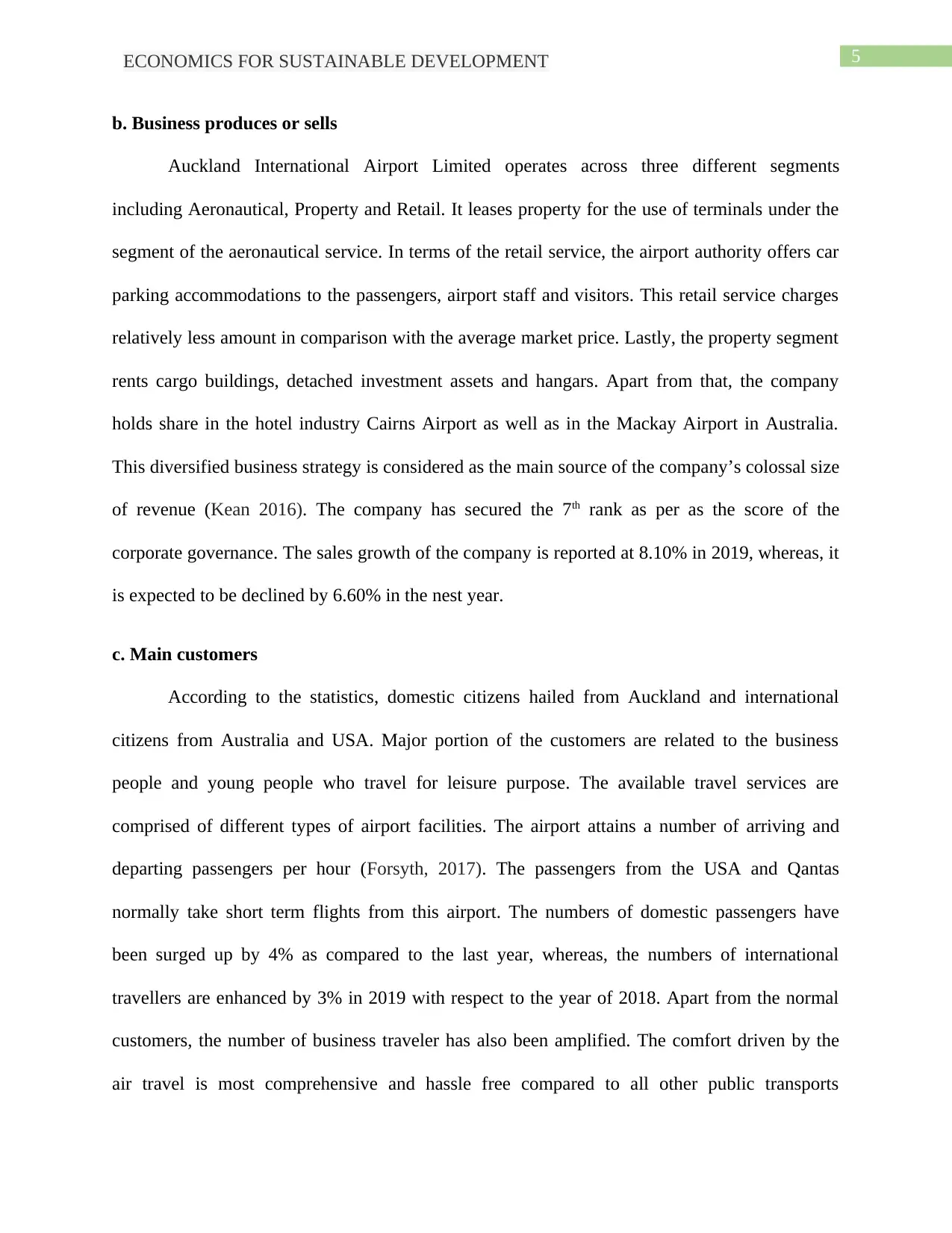
5ECONOMICS FOR SUSTAINABLE DEVELOPMENT
b. Business produces or sells
Auckland International Airport Limited operates across three different segments
including Aeronautical, Property and Retail. It leases property for the use of terminals under the
segment of the aeronautical service. In terms of the retail service, the airport authority offers car
parking accommodations to the passengers, airport staff and visitors. This retail service charges
relatively less amount in comparison with the average market price. Lastly, the property segment
rents cargo buildings, detached investment assets and hangars. Apart from that, the company
holds share in the hotel industry Cairns Airport as well as in the Mackay Airport in Australia.
This diversified business strategy is considered as the main source of the company’s colossal size
of revenue (Kean 2016). The company has secured the 7th rank as per as the score of the
corporate governance. The sales growth of the company is reported at 8.10% in 2019, whereas, it
is expected to be declined by 6.60% in the nest year.
c. Main customers
According to the statistics, domestic citizens hailed from Auckland and international
citizens from Australia and USA. Major portion of the customers are related to the business
people and young people who travel for leisure purpose. The available travel services are
comprised of different types of airport facilities. The airport attains a number of arriving and
departing passengers per hour (Forsyth, 2017). The passengers from the USA and Qantas
normally take short term flights from this airport. The numbers of domestic passengers have
been surged up by 4% as compared to the last year, whereas, the numbers of international
travellers are enhanced by 3% in 2019 with respect to the year of 2018. Apart from the normal
customers, the number of business traveler has also been amplified. The comfort driven by the
air travel is most comprehensive and hassle free compared to all other public transports
b. Business produces or sells
Auckland International Airport Limited operates across three different segments
including Aeronautical, Property and Retail. It leases property for the use of terminals under the
segment of the aeronautical service. In terms of the retail service, the airport authority offers car
parking accommodations to the passengers, airport staff and visitors. This retail service charges
relatively less amount in comparison with the average market price. Lastly, the property segment
rents cargo buildings, detached investment assets and hangars. Apart from that, the company
holds share in the hotel industry Cairns Airport as well as in the Mackay Airport in Australia.
This diversified business strategy is considered as the main source of the company’s colossal size
of revenue (Kean 2016). The company has secured the 7th rank as per as the score of the
corporate governance. The sales growth of the company is reported at 8.10% in 2019, whereas, it
is expected to be declined by 6.60% in the nest year.
c. Main customers
According to the statistics, domestic citizens hailed from Auckland and international
citizens from Australia and USA. Major portion of the customers are related to the business
people and young people who travel for leisure purpose. The available travel services are
comprised of different types of airport facilities. The airport attains a number of arriving and
departing passengers per hour (Forsyth, 2017). The passengers from the USA and Qantas
normally take short term flights from this airport. The numbers of domestic passengers have
been surged up by 4% as compared to the last year, whereas, the numbers of international
travellers are enhanced by 3% in 2019 with respect to the year of 2018. Apart from the normal
customers, the number of business traveler has also been amplified. The comfort driven by the
air travel is most comprehensive and hassle free compared to all other public transports
⊘ This is a preview!⊘
Do you want full access?
Subscribe today to unlock all pages.

Trusted by 1+ million students worldwide
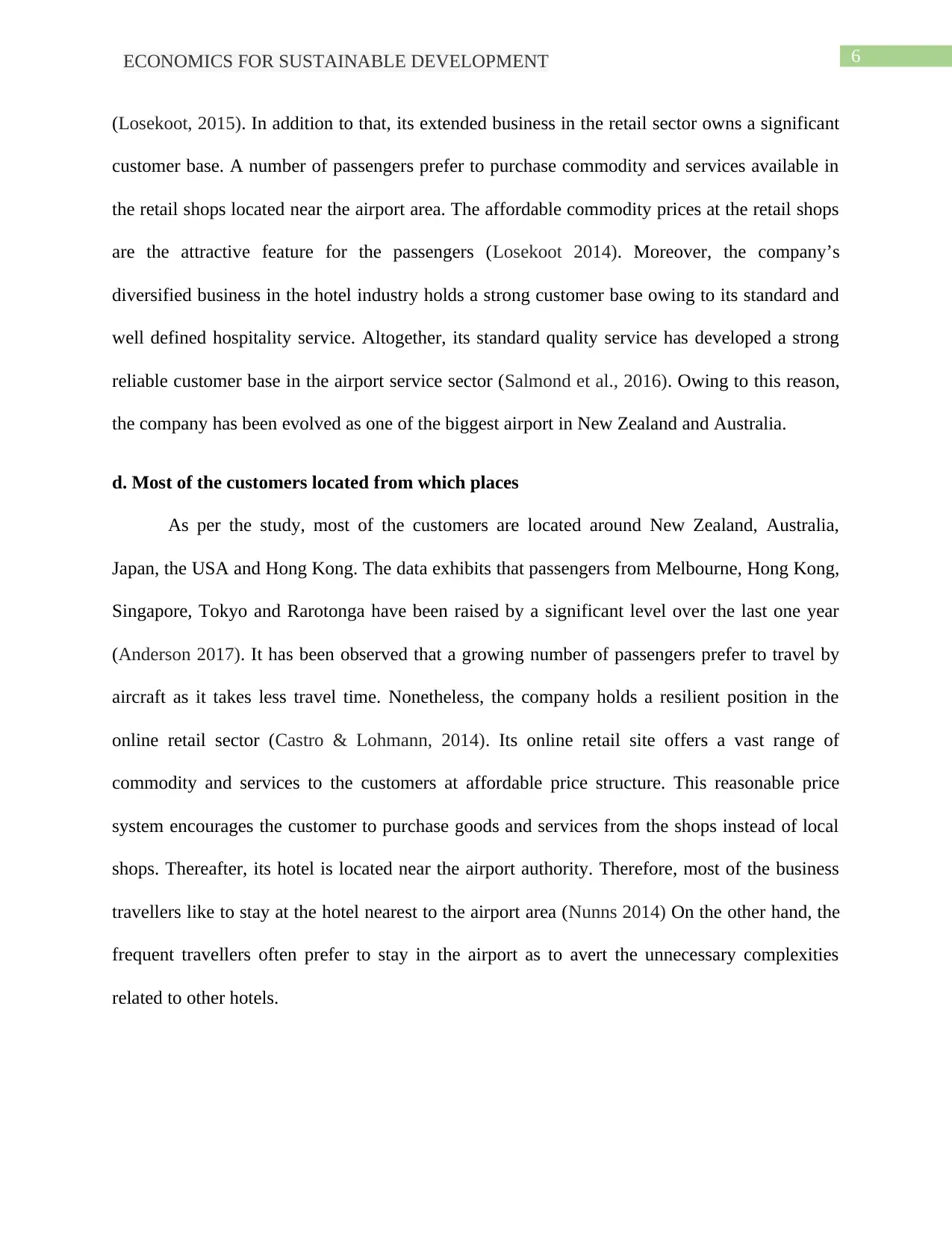
6ECONOMICS FOR SUSTAINABLE DEVELOPMENT
(Losekoot, 2015). In addition to that, its extended business in the retail sector owns a significant
customer base. A number of passengers prefer to purchase commodity and services available in
the retail shops located near the airport area. The affordable commodity prices at the retail shops
are the attractive feature for the passengers (Losekoot 2014). Moreover, the company’s
diversified business in the hotel industry holds a strong customer base owing to its standard and
well defined hospitality service. Altogether, its standard quality service has developed a strong
reliable customer base in the airport service sector (Salmond et al., 2016). Owing to this reason,
the company has been evolved as one of the biggest airport in New Zealand and Australia.
d. Most of the customers located from which places
As per the study, most of the customers are located around New Zealand, Australia,
Japan, the USA and Hong Kong. The data exhibits that passengers from Melbourne, Hong Kong,
Singapore, Tokyo and Rarotonga have been raised by a significant level over the last one year
(Anderson 2017). It has been observed that a growing number of passengers prefer to travel by
aircraft as it takes less travel time. Nonetheless, the company holds a resilient position in the
online retail sector (Castro & Lohmann, 2014). Its online retail site offers a vast range of
commodity and services to the customers at affordable price structure. This reasonable price
system encourages the customer to purchase goods and services from the shops instead of local
shops. Thereafter, its hotel is located near the airport authority. Therefore, most of the business
travellers like to stay at the hotel nearest to the airport area (Nunns 2014) On the other hand, the
frequent travellers often prefer to stay in the airport as to avert the unnecessary complexities
related to other hotels.
(Losekoot, 2015). In addition to that, its extended business in the retail sector owns a significant
customer base. A number of passengers prefer to purchase commodity and services available in
the retail shops located near the airport area. The affordable commodity prices at the retail shops
are the attractive feature for the passengers (Losekoot 2014). Moreover, the company’s
diversified business in the hotel industry holds a strong customer base owing to its standard and
well defined hospitality service. Altogether, its standard quality service has developed a strong
reliable customer base in the airport service sector (Salmond et al., 2016). Owing to this reason,
the company has been evolved as one of the biggest airport in New Zealand and Australia.
d. Most of the customers located from which places
As per the study, most of the customers are located around New Zealand, Australia,
Japan, the USA and Hong Kong. The data exhibits that passengers from Melbourne, Hong Kong,
Singapore, Tokyo and Rarotonga have been raised by a significant level over the last one year
(Anderson 2017). It has been observed that a growing number of passengers prefer to travel by
aircraft as it takes less travel time. Nonetheless, the company holds a resilient position in the
online retail sector (Castro & Lohmann, 2014). Its online retail site offers a vast range of
commodity and services to the customers at affordable price structure. This reasonable price
system encourages the customer to purchase goods and services from the shops instead of local
shops. Thereafter, its hotel is located near the airport authority. Therefore, most of the business
travellers like to stay at the hotel nearest to the airport area (Nunns 2014) On the other hand, the
frequent travellers often prefer to stay in the airport as to avert the unnecessary complexities
related to other hotels.
Paraphrase This Document
Need a fresh take? Get an instant paraphrase of this document with our AI Paraphraser
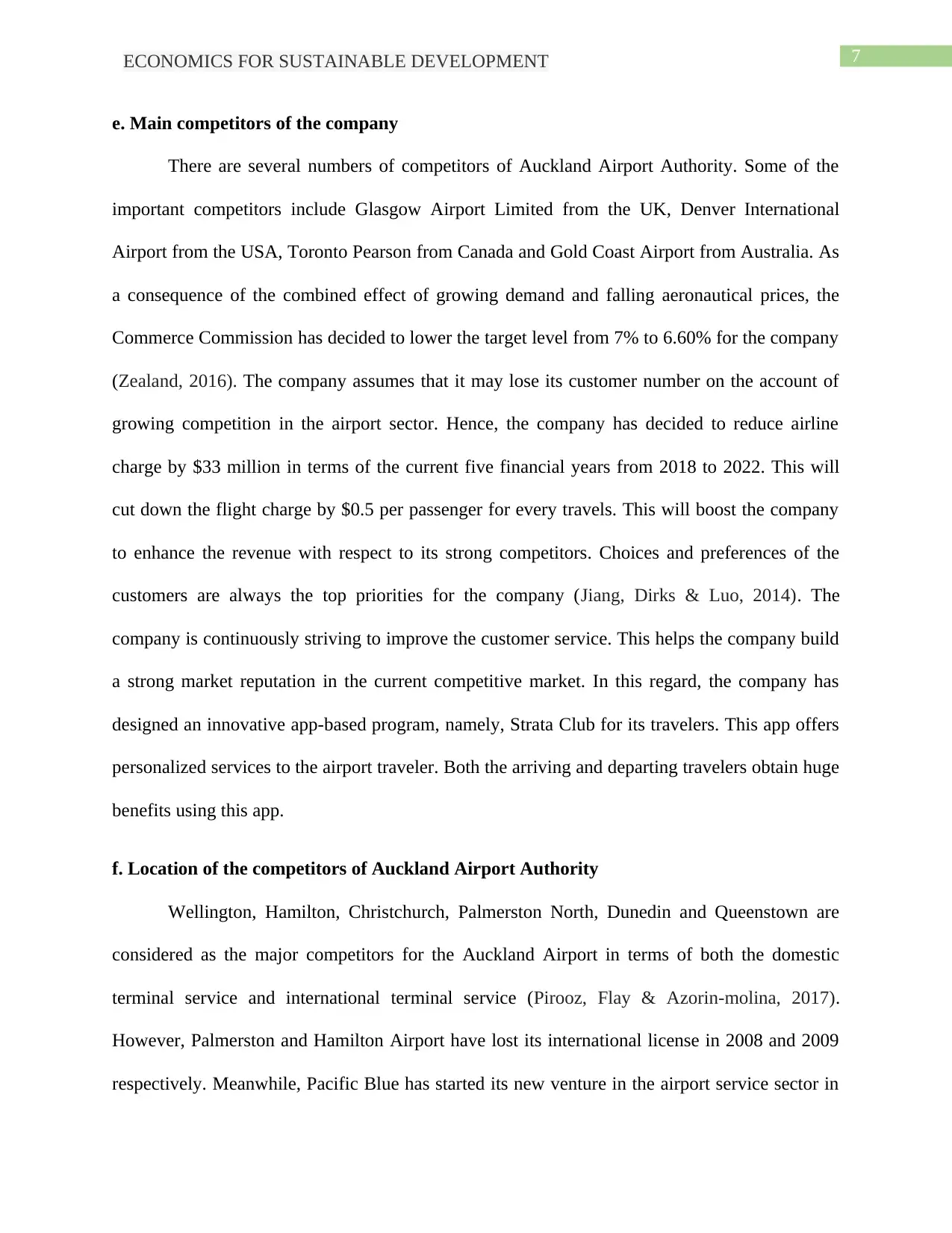
7ECONOMICS FOR SUSTAINABLE DEVELOPMENT
e. Main competitors of the company
There are several numbers of competitors of Auckland Airport Authority. Some of the
important competitors include Glasgow Airport Limited from the UK, Denver International
Airport from the USA, Toronto Pearson from Canada and Gold Coast Airport from Australia. As
a consequence of the combined effect of growing demand and falling aeronautical prices, the
Commerce Commission has decided to lower the target level from 7% to 6.60% for the company
(Zealand, 2016). The company assumes that it may lose its customer number on the account of
growing competition in the airport sector. Hence, the company has decided to reduce airline
charge by $33 million in terms of the current five financial years from 2018 to 2022. This will
cut down the flight charge by $0.5 per passenger for every travels. This will boost the company
to enhance the revenue with respect to its strong competitors. Choices and preferences of the
customers are always the top priorities for the company (Jiang, Dirks & Luo, 2014). The
company is continuously striving to improve the customer service. This helps the company build
a strong market reputation in the current competitive market. In this regard, the company has
designed an innovative app-based program, namely, Strata Club for its travelers. This app offers
personalized services to the airport traveler. Both the arriving and departing travelers obtain huge
benefits using this app.
f. Location of the competitors of Auckland Airport Authority
Wellington, Hamilton, Christchurch, Palmerston North, Dunedin and Queenstown are
considered as the major competitors for the Auckland Airport in terms of both the domestic
terminal service and international terminal service (Pirooz, Flay & Azorin-molina, 2017).
However, Palmerston and Hamilton Airport have lost its international license in 2008 and 2009
respectively. Meanwhile, Pacific Blue has started its new venture in the airport service sector in
e. Main competitors of the company
There are several numbers of competitors of Auckland Airport Authority. Some of the
important competitors include Glasgow Airport Limited from the UK, Denver International
Airport from the USA, Toronto Pearson from Canada and Gold Coast Airport from Australia. As
a consequence of the combined effect of growing demand and falling aeronautical prices, the
Commerce Commission has decided to lower the target level from 7% to 6.60% for the company
(Zealand, 2016). The company assumes that it may lose its customer number on the account of
growing competition in the airport sector. Hence, the company has decided to reduce airline
charge by $33 million in terms of the current five financial years from 2018 to 2022. This will
cut down the flight charge by $0.5 per passenger for every travels. This will boost the company
to enhance the revenue with respect to its strong competitors. Choices and preferences of the
customers are always the top priorities for the company (Jiang, Dirks & Luo, 2014). The
company is continuously striving to improve the customer service. This helps the company build
a strong market reputation in the current competitive market. In this regard, the company has
designed an innovative app-based program, namely, Strata Club for its travelers. This app offers
personalized services to the airport traveler. Both the arriving and departing travelers obtain huge
benefits using this app.
f. Location of the competitors of Auckland Airport Authority
Wellington, Hamilton, Christchurch, Palmerston North, Dunedin and Queenstown are
considered as the major competitors for the Auckland Airport in terms of both the domestic
terminal service and international terminal service (Pirooz, Flay & Azorin-molina, 2017).
However, Palmerston and Hamilton Airport have lost its international license in 2008 and 2009
respectively. Meanwhile, Pacific Blue has started its new venture in the airport service sector in
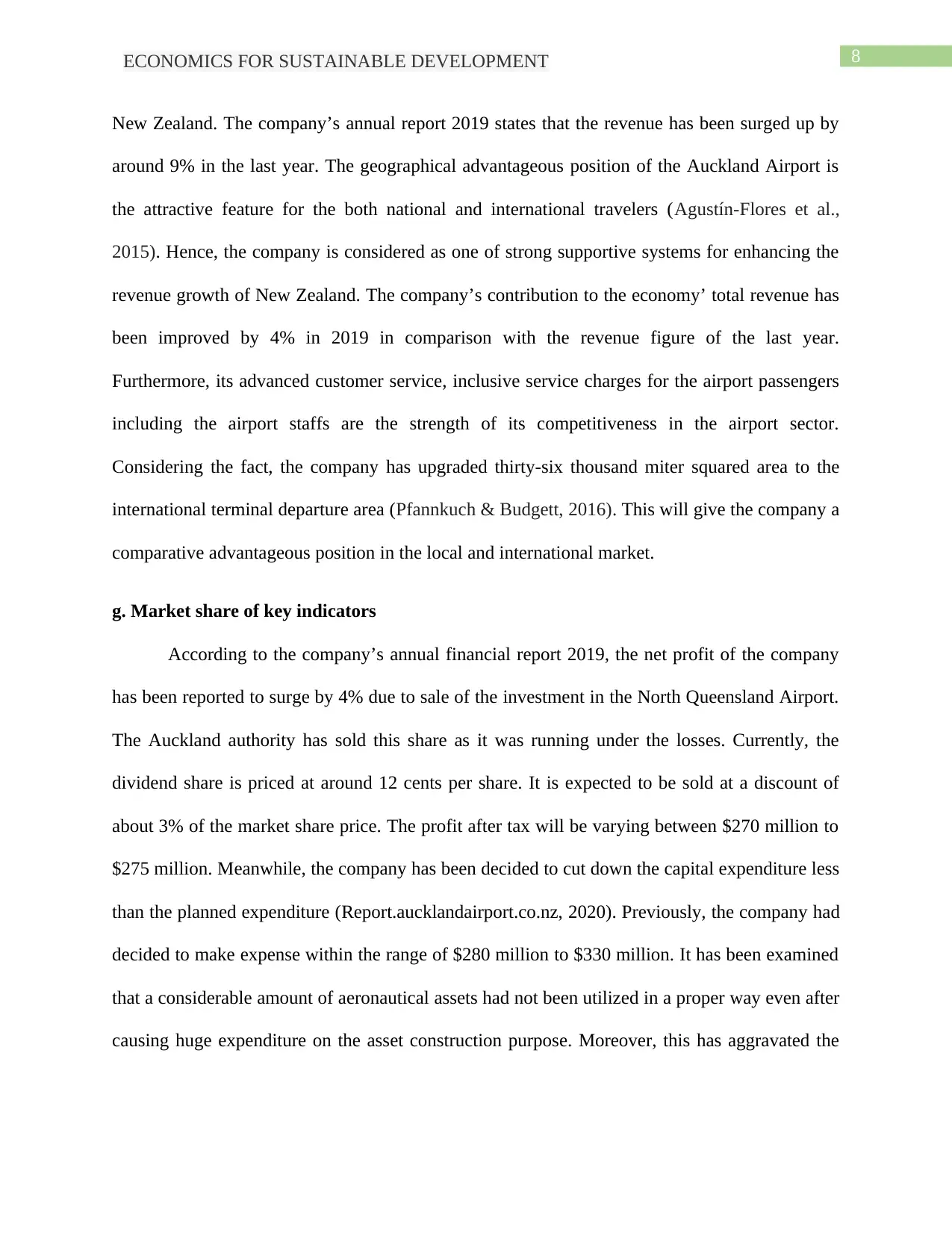
8ECONOMICS FOR SUSTAINABLE DEVELOPMENT
New Zealand. The company’s annual report 2019 states that the revenue has been surged up by
around 9% in the last year. The geographical advantageous position of the Auckland Airport is
the attractive feature for the both national and international travelers (Agustín-Flores et al.,
2015). Hence, the company is considered as one of strong supportive systems for enhancing the
revenue growth of New Zealand. The company’s contribution to the economy’ total revenue has
been improved by 4% in 2019 in comparison with the revenue figure of the last year.
Furthermore, its advanced customer service, inclusive service charges for the airport passengers
including the airport staffs are the strength of its competitiveness in the airport sector.
Considering the fact, the company has upgraded thirty-six thousand miter squared area to the
international terminal departure area (Pfannkuch & Budgett, 2016). This will give the company a
comparative advantageous position in the local and international market.
g. Market share of key indicators
According to the company’s annual financial report 2019, the net profit of the company
has been reported to surge by 4% due to sale of the investment in the North Queensland Airport.
The Auckland authority has sold this share as it was running under the losses. Currently, the
dividend share is priced at around 12 cents per share. It is expected to be sold at a discount of
about 3% of the market share price. The profit after tax will be varying between $270 million to
$275 million. Meanwhile, the company has been decided to cut down the capital expenditure less
than the planned expenditure (Report.aucklandairport.co.nz, 2020). Previously, the company had
decided to make expense within the range of $280 million to $330 million. It has been examined
that a considerable amount of aeronautical assets had not been utilized in a proper way even after
causing huge expenditure on the asset construction purpose. Moreover, this has aggravated the
New Zealand. The company’s annual report 2019 states that the revenue has been surged up by
around 9% in the last year. The geographical advantageous position of the Auckland Airport is
the attractive feature for the both national and international travelers (Agustín-Flores et al.,
2015). Hence, the company is considered as one of strong supportive systems for enhancing the
revenue growth of New Zealand. The company’s contribution to the economy’ total revenue has
been improved by 4% in 2019 in comparison with the revenue figure of the last year.
Furthermore, its advanced customer service, inclusive service charges for the airport passengers
including the airport staffs are the strength of its competitiveness in the airport sector.
Considering the fact, the company has upgraded thirty-six thousand miter squared area to the
international terminal departure area (Pfannkuch & Budgett, 2016). This will give the company a
comparative advantageous position in the local and international market.
g. Market share of key indicators
According to the company’s annual financial report 2019, the net profit of the company
has been reported to surge by 4% due to sale of the investment in the North Queensland Airport.
The Auckland authority has sold this share as it was running under the losses. Currently, the
dividend share is priced at around 12 cents per share. It is expected to be sold at a discount of
about 3% of the market share price. The profit after tax will be varying between $270 million to
$275 million. Meanwhile, the company has been decided to cut down the capital expenditure less
than the planned expenditure (Report.aucklandairport.co.nz, 2020). Previously, the company had
decided to make expense within the range of $280 million to $330 million. It has been examined
that a considerable amount of aeronautical assets had not been utilized in a proper way even after
causing huge expenditure on the asset construction purpose. Moreover, this has aggravated the
⊘ This is a preview!⊘
Do you want full access?
Subscribe today to unlock all pages.

Trusted by 1+ million students worldwide

9ECONOMICS FOR SUSTAINABLE DEVELOPMENT
financial loss of the company. Therefore, cut down in the capital expenditure will intensify the
profit as well as appreciates the markets share of the company.
Production costs and scale
a. Fixed cost
Fixed cost refers to that cost which never changes with respect to the change in the
production quantity. In this context, the lounge area, hotel infrastructure, airport infrastructure
and parking slots are termed as the fixed capital. Therefore, expenses related to this fixed capital
will be under the fixed cost for the Auckland Airport Authority. The company will have to bear
these expenses whatever the revenue it generates (In, Casemiro & Kim, 2017). Recession,
inflation, stagflation and stagnation never alter this cost amount for the company. The authority
is advised to develop possible policies which will control the fixed cost of the projects. For
example, the company can link 3D models to the time schedule, workflow and logistic
operations to evaluate the cost structure of the company (Alter, 2015). This will result in
improvement of the streamline project and steadfastness complex construction challenges related
to the fixed cost.
b. Variable cost
Variable cost varies along with the quantity of the production. The cost cannot be fixed.
The cost related to the raw materials, labor and packaging are considered under the variable cost.
Contextually, the Auckland Airport Authority makes some corporate expenses owing to
overhauling the airport operation on the daily basis (Davis et al., 2016). The company has
experienced a growing operating cost coupled with increasing depreciation expenses associated
with the airport infrastructure. According to the company’s report of 2019, the operating cost has
financial loss of the company. Therefore, cut down in the capital expenditure will intensify the
profit as well as appreciates the markets share of the company.
Production costs and scale
a. Fixed cost
Fixed cost refers to that cost which never changes with respect to the change in the
production quantity. In this context, the lounge area, hotel infrastructure, airport infrastructure
and parking slots are termed as the fixed capital. Therefore, expenses related to this fixed capital
will be under the fixed cost for the Auckland Airport Authority. The company will have to bear
these expenses whatever the revenue it generates (In, Casemiro & Kim, 2017). Recession,
inflation, stagflation and stagnation never alter this cost amount for the company. The authority
is advised to develop possible policies which will control the fixed cost of the projects. For
example, the company can link 3D models to the time schedule, workflow and logistic
operations to evaluate the cost structure of the company (Alter, 2015). This will result in
improvement of the streamline project and steadfastness complex construction challenges related
to the fixed cost.
b. Variable cost
Variable cost varies along with the quantity of the production. The cost cannot be fixed.
The cost related to the raw materials, labor and packaging are considered under the variable cost.
Contextually, the Auckland Airport Authority makes some corporate expenses owing to
overhauling the airport operation on the daily basis (Davis et al., 2016). The company has
experienced a growing operating cost coupled with increasing depreciation expenses associated
with the airport infrastructure. According to the company’s report of 2019, the operating cost has
Paraphrase This Document
Need a fresh take? Get an instant paraphrase of this document with our AI Paraphraser
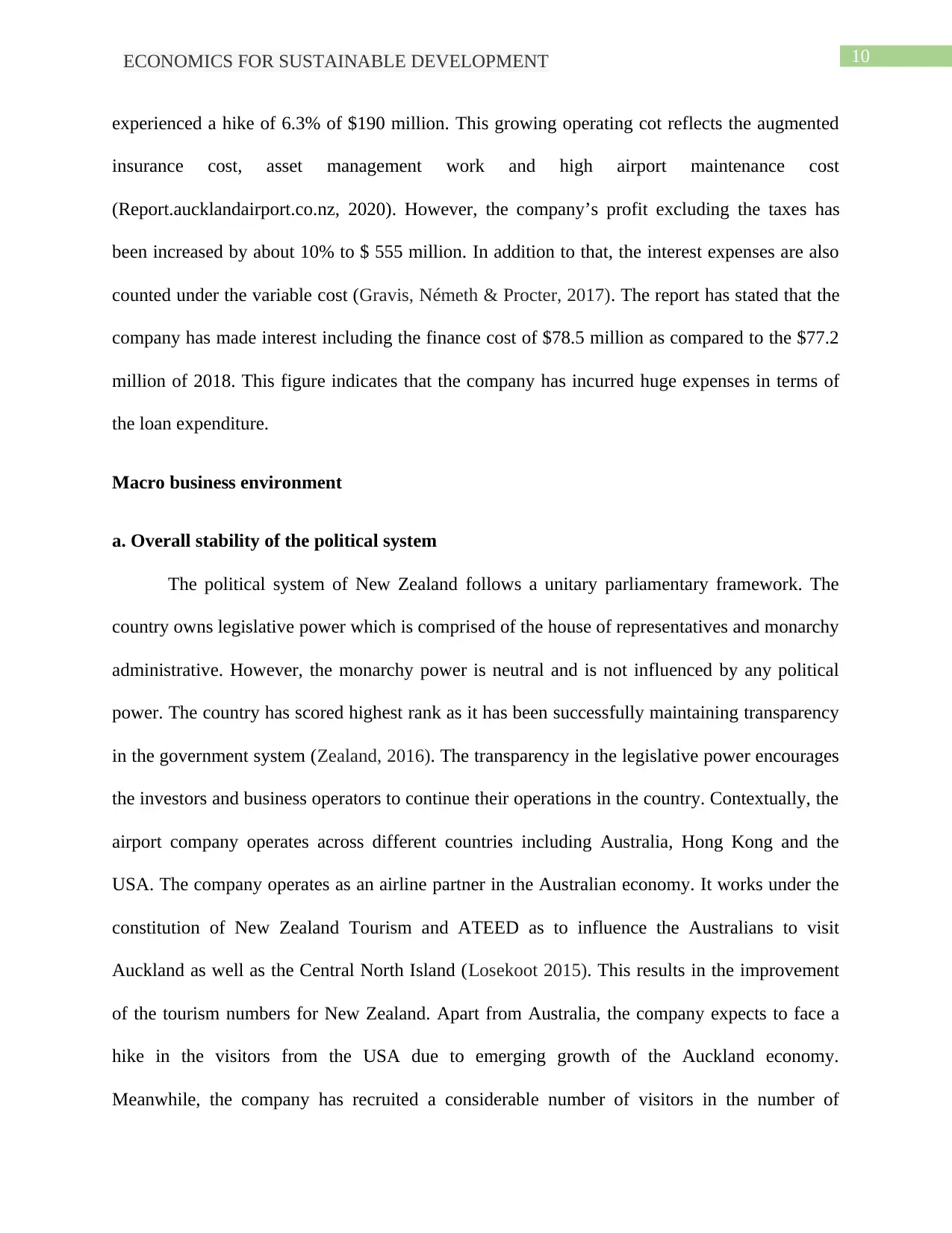
10ECONOMICS FOR SUSTAINABLE DEVELOPMENT
experienced a hike of 6.3% of $190 million. This growing operating cot reflects the augmented
insurance cost, asset management work and high airport maintenance cost
(Report.aucklandairport.co.nz, 2020). However, the company’s profit excluding the taxes has
been increased by about 10% to $ 555 million. In addition to that, the interest expenses are also
counted under the variable cost (Gravis, Németh & Procter, 2017). The report has stated that the
company has made interest including the finance cost of $78.5 million as compared to the $77.2
million of 2018. This figure indicates that the company has incurred huge expenses in terms of
the loan expenditure.
Macro business environment
a. Overall stability of the political system
The political system of New Zealand follows a unitary parliamentary framework. The
country owns legislative power which is comprised of the house of representatives and monarchy
administrative. However, the monarchy power is neutral and is not influenced by any political
power. The country has scored highest rank as it has been successfully maintaining transparency
in the government system (Zealand, 2016). The transparency in the legislative power encourages
the investors and business operators to continue their operations in the country. Contextually, the
airport company operates across different countries including Australia, Hong Kong and the
USA. The company operates as an airline partner in the Australian economy. It works under the
constitution of New Zealand Tourism and ATEED as to influence the Australians to visit
Auckland as well as the Central North Island (Losekoot 2015). This results in the improvement
of the tourism numbers for New Zealand. Apart from Australia, the company expects to face a
hike in the visitors from the USA due to emerging growth of the Auckland economy.
Meanwhile, the company has recruited a considerable number of visitors in the number of
experienced a hike of 6.3% of $190 million. This growing operating cot reflects the augmented
insurance cost, asset management work and high airport maintenance cost
(Report.aucklandairport.co.nz, 2020). However, the company’s profit excluding the taxes has
been increased by about 10% to $ 555 million. In addition to that, the interest expenses are also
counted under the variable cost (Gravis, Németh & Procter, 2017). The report has stated that the
company has made interest including the finance cost of $78.5 million as compared to the $77.2
million of 2018. This figure indicates that the company has incurred huge expenses in terms of
the loan expenditure.
Macro business environment
a. Overall stability of the political system
The political system of New Zealand follows a unitary parliamentary framework. The
country owns legislative power which is comprised of the house of representatives and monarchy
administrative. However, the monarchy power is neutral and is not influenced by any political
power. The country has scored highest rank as it has been successfully maintaining transparency
in the government system (Zealand, 2016). The transparency in the legislative power encourages
the investors and business operators to continue their operations in the country. Contextually, the
airport company operates across different countries including Australia, Hong Kong and the
USA. The company operates as an airline partner in the Australian economy. It works under the
constitution of New Zealand Tourism and ATEED as to influence the Australians to visit
Auckland as well as the Central North Island (Losekoot 2015). This results in the improvement
of the tourism numbers for New Zealand. Apart from Australia, the company expects to face a
hike in the visitors from the USA due to emerging growth of the Auckland economy.
Meanwhile, the company has recruited a considerable number of visitors in the number of
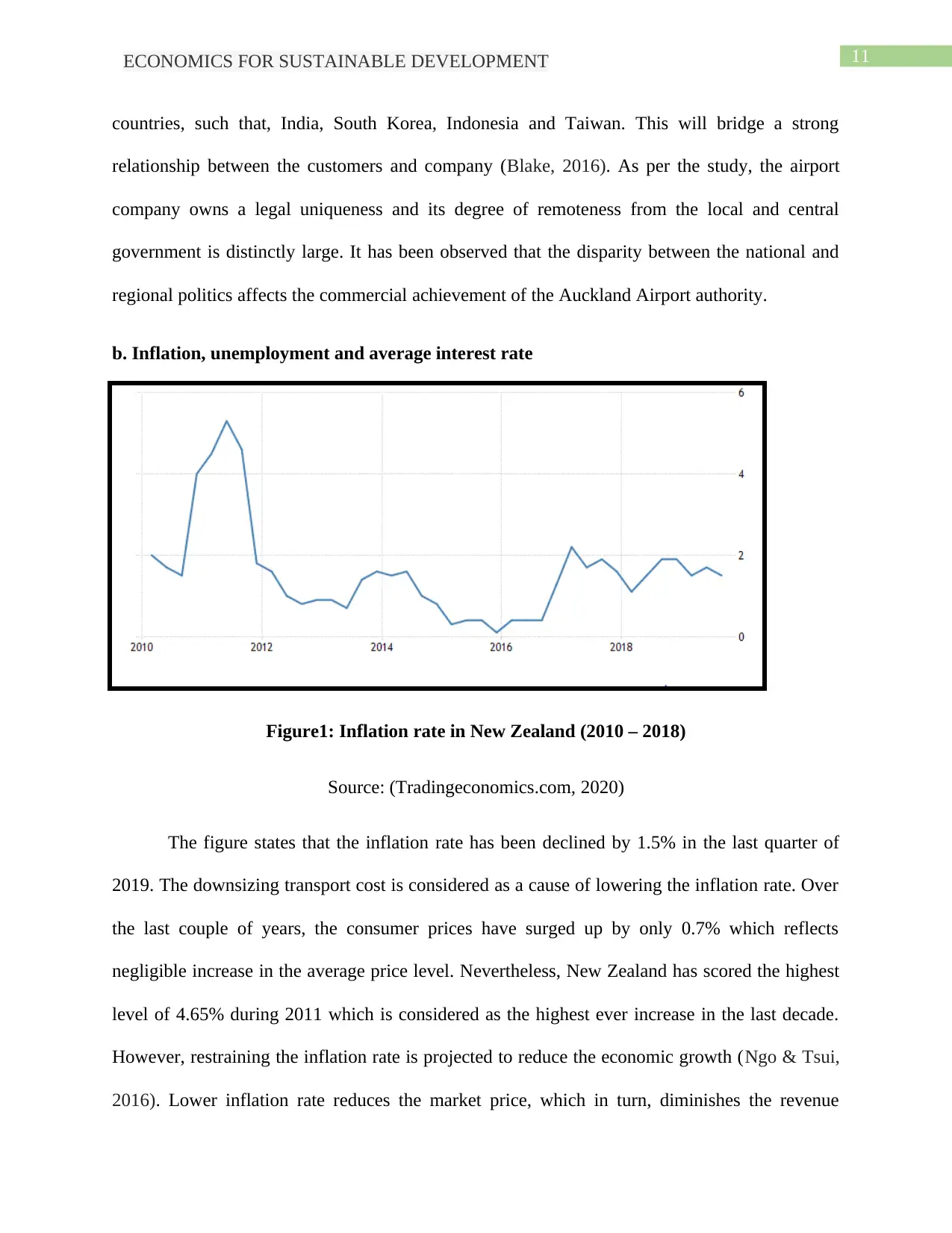
11ECONOMICS FOR SUSTAINABLE DEVELOPMENT
countries, such that, India, South Korea, Indonesia and Taiwan. This will bridge a strong
relationship between the customers and company (Blake, 2016). As per the study, the airport
company owns a legal uniqueness and its degree of remoteness from the local and central
government is distinctly large. It has been observed that the disparity between the national and
regional politics affects the commercial achievement of the Auckland Airport authority.
b. Inflation, unemployment and average interest rate
Figure1: Inflation rate in New Zealand (2010 – 2018)
Source: (Tradingeconomics.com, 2020)
The figure states that the inflation rate has been declined by 1.5% in the last quarter of
2019. The downsizing transport cost is considered as a cause of lowering the inflation rate. Over
the last couple of years, the consumer prices have surged up by only 0.7% which reflects
negligible increase in the average price level. Nevertheless, New Zealand has scored the highest
level of 4.65% during 2011 which is considered as the highest ever increase in the last decade.
However, restraining the inflation rate is projected to reduce the economic growth (Ngo & Tsui,
2016). Lower inflation rate reduces the market price, which in turn, diminishes the revenue
countries, such that, India, South Korea, Indonesia and Taiwan. This will bridge a strong
relationship between the customers and company (Blake, 2016). As per the study, the airport
company owns a legal uniqueness and its degree of remoteness from the local and central
government is distinctly large. It has been observed that the disparity between the national and
regional politics affects the commercial achievement of the Auckland Airport authority.
b. Inflation, unemployment and average interest rate
Figure1: Inflation rate in New Zealand (2010 – 2018)
Source: (Tradingeconomics.com, 2020)
The figure states that the inflation rate has been declined by 1.5% in the last quarter of
2019. The downsizing transport cost is considered as a cause of lowering the inflation rate. Over
the last couple of years, the consumer prices have surged up by only 0.7% which reflects
negligible increase in the average price level. Nevertheless, New Zealand has scored the highest
level of 4.65% during 2011 which is considered as the highest ever increase in the last decade.
However, restraining the inflation rate is projected to reduce the economic growth (Ngo & Tsui,
2016). Lower inflation rate reduces the market price, which in turn, diminishes the revenue
⊘ This is a preview!⊘
Do you want full access?
Subscribe today to unlock all pages.

Trusted by 1+ million students worldwide
1 out of 22
Related Documents
Your All-in-One AI-Powered Toolkit for Academic Success.
+13062052269
info@desklib.com
Available 24*7 on WhatsApp / Email
![[object Object]](/_next/static/media/star-bottom.7253800d.svg)
Unlock your academic potential
Copyright © 2020–2025 A2Z Services. All Rights Reserved. Developed and managed by ZUCOL.





